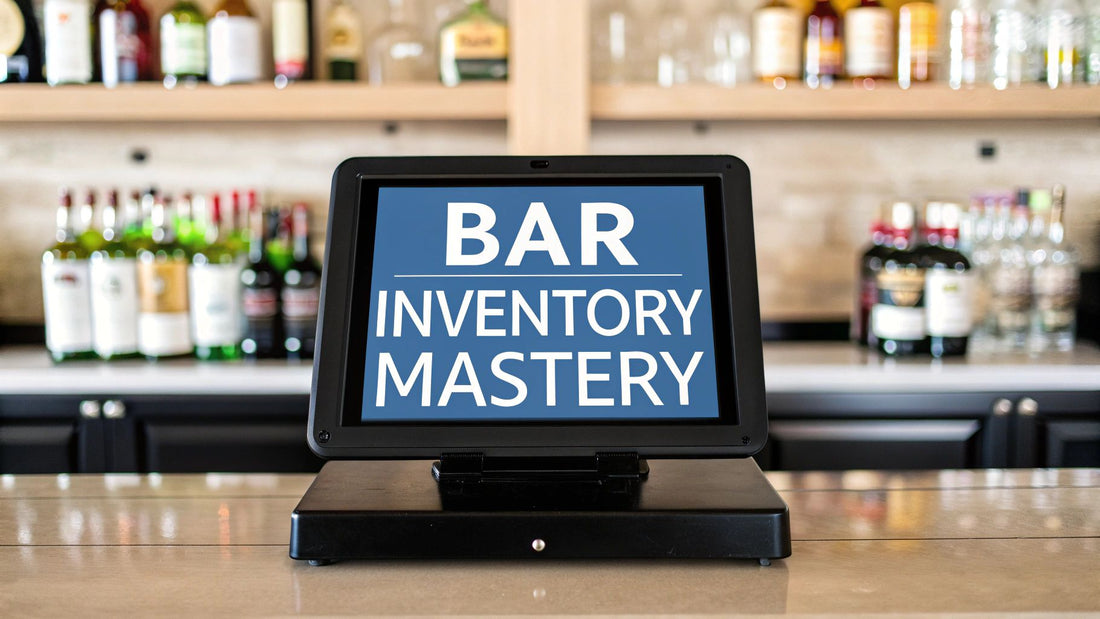
Mastering Bar Inventory Management Systems
Share
A bar inventory management system is, at its core, a way to keep tabs on every bottle of liquor, beer, and wine you have. It’s a combination of tools and smart processes that track your stock, watch your sales, and help you cut down on waste. Think of it as moving from a clipboard and guesswork to a digital solution that shows you exactly where every ounce of alcohol goes. This shift can turn your beverage program from a frustrating cost center into a serious profit driver, keeping you informed on the latest industry trends.
Why Bar Inventory Is Your Most Critical Asset
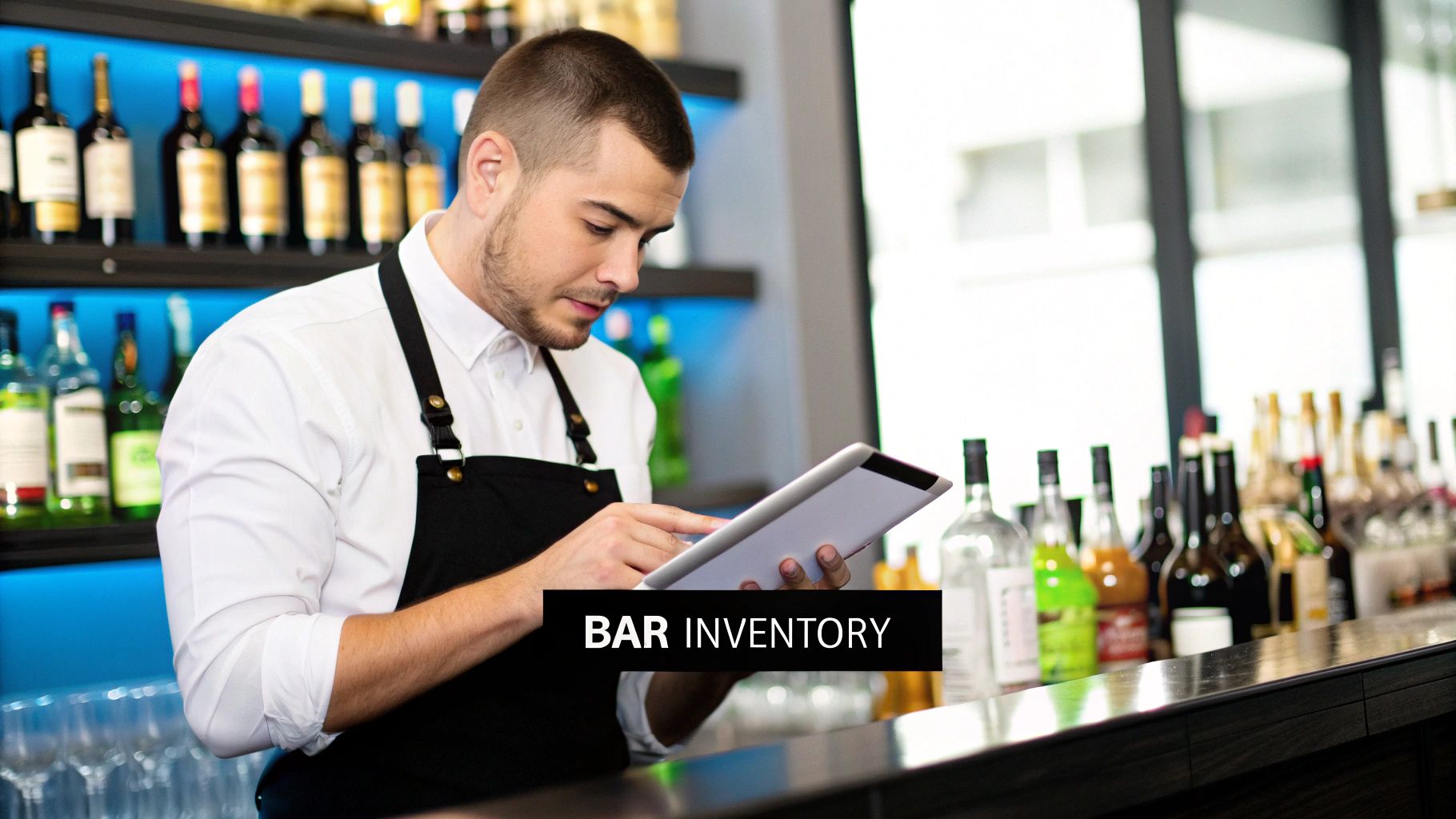
As a restaurant owner or manager, it's easy to look at the back bar and just see bottles on a shelf. But that’s not what they are—your inventory is liquid cash, plain and simple. Every unrecorded pour, every spilled drink, every bottle that walks out the back door… it all comes directly off your bottom line. During a busy service, that chaos makes it almost impossible to protect this asset without a system built for the job.
This is where a bar inventory management system proves its worth. It’s the tool that brings order to the chaos and gives you a clear, honest look at one of your business's biggest investments. Staying informed with the right tools is the first step to leveraging industry trends to your advantage.
Moving Beyond Manual Counts
Let's be honest: traditional inventory methods are a drag. They’re not just slow, they’re notoriously inaccurate. Those late-night manual counts are a breeding ground for errors, and those small mistakes can easily mask much bigger problems that slowly drain your profits month after month.
A modern system automates the whole process and tackles the issues that kill your margins:
- Over-pouring: Just a quarter-ounce extra in each drink doesn't sound like much, but it adds up to staggering losses over a year.
- Theft: When inventory isn't being watched closely, it’s far too easy for bottles or free drinks to disappear without a trace.
- Waste: Spills and spoiled products often go unnoticed without a precise way to track them.
- Poor Purchasing Decisions: When you’re just guessing, you end up with a stockroom full of slow-movers while running out of your best-sellers on a Friday night.
The financial stakes are incredibly high. A bar with poorly managed inventory can see losses chew up 15% to 20% of its revenue from shrinkage and waste alone. On the flip side, bars with tight controls can hit gross margins between 72% and 82%, which is a massive boost to their financial health.
In today's market, you also have to keep an eye on external forces. Understanding how tariffs, supply chain disruptions, and other factors are shaping the hospitality industry can help you get ahead of sudden cost changes. Taking control of your beverage program is the first and most important step to staying competitive and profitable in a very tough business.
What to Look for in a Bar Inventory System
Think of modern bar inventory software as the central nervous system for your beverage program, not just a fancy digital spreadsheet. It’s the engine that drives profitability. Instead of getting bogged down in technical jargon, let's break down what these core features actually do for your bar in the real world. Knowing how these tools work in concert is the secret to taking back control of your operations and staying on top of industry trends.
At its core, any good system offers real-time tracking. This is your 24/7 watchdog. It keeps a constant eye on every bottle, keg, and can, so you never get caught off guard when you run out of your best-selling IPA on a packed Friday night. This live oversight is your best defense against easily avoidable losses and unhappy customers.
Connecting Sales directly to Stock Levels
The real magic, though, is Point of Sale (POS) integration. This is what connects the dots. It acts as the bridge between what your bartenders are selling and what you have on the shelves.
When a server rings up a margarita, the system instantly deducts the exact ounces of tequila, triple sec, and lime juice from your inventory count. This completely removes the manual guesswork and painful end-of-night reconciliations that make traditional inventory a nightmare. It gives you a crystal-clear, up-to-the-minute view of your bar's performance, transforming simple sales data into powerful business insights.
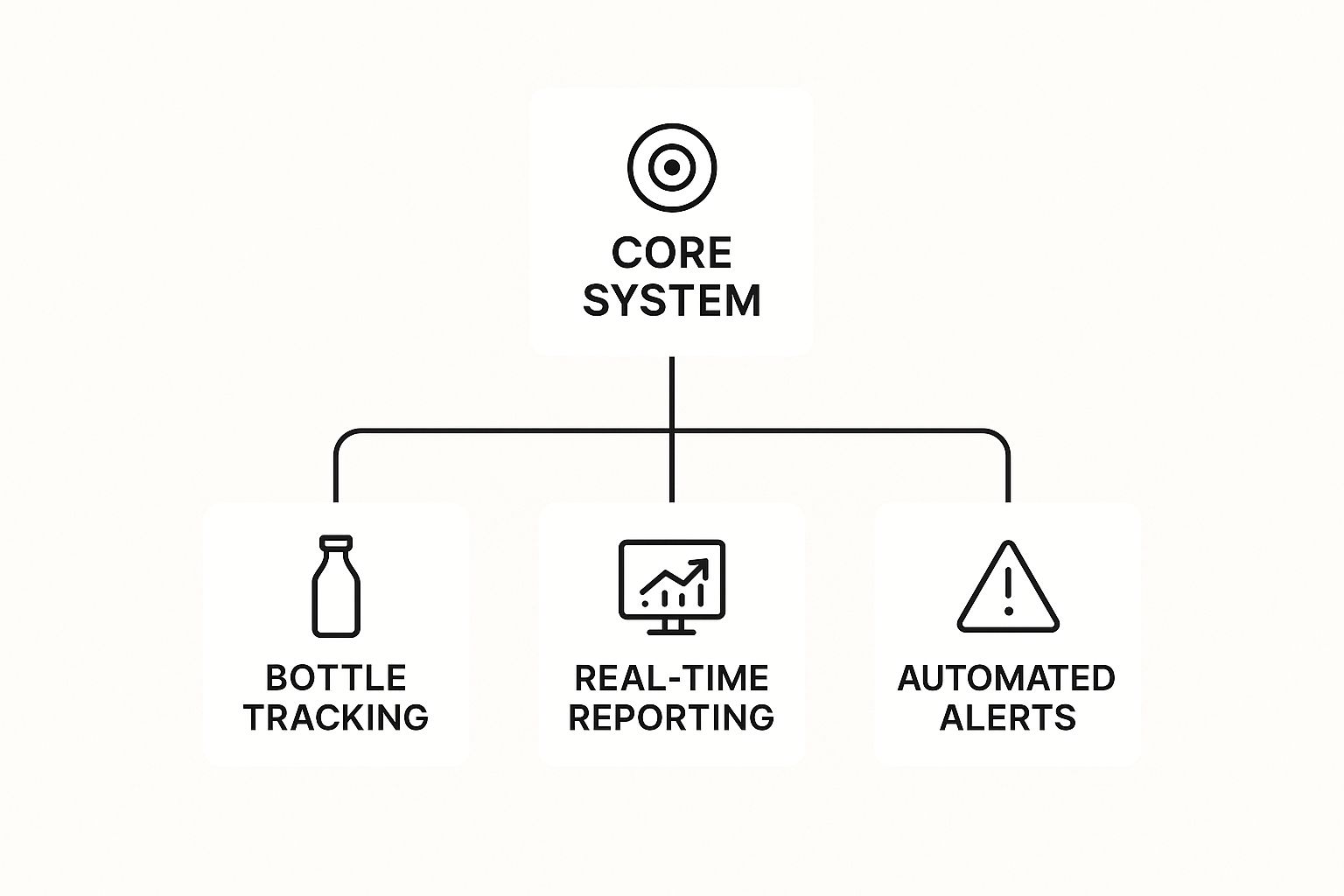
This kind of integration is fundamental. As you can see, foundational features like tracking individual bottles feed directly into more advanced functions like instant reporting and alerts, creating a truly unified management tool.
Putting Tedious Tasks on Autopilot
Let’s be honest, nobody enjoys manually creating purchase orders. That’s where automated ordering comes in. The software learns your sales velocity and, based on the par levels you set (the minimum stock you always want on hand), it generates perfectly accurate purchase orders for you. This frees up your managers from hours of administrative drudgery and prevents the classic costly mistakes: overstocking on slow-movers and running dry on your biggest sellers.
By putting routine tasks on autopilot, your team can finally step away from the clipboards and focus on what actually grows the business—crafting amazing guest experiences and driving sales. That shift is where the real return on investment happens.
To give you a clearer picture, here’s a breakdown of the essential features and why they matter so much to your bottom line.
Essential Features of Bar Inventory Management Software
This table breaks down the core functionalities of modern systems and explains their direct impact on bar operations and profitability.
| Feature | What It Does | Primary Benefit |
|---|---|---|
| Real-Time Tracking | Monitors every unit of liquor, beer, and wine as it's received, depleted, and sold. | Prevents stockouts of popular items and provides an accurate, live view of inventory value. |
| POS Integration | Automatically deducts ingredients from inventory with every sale recorded at the point of sale. | Eliminates manual data entry, reduces human error, and provides instant sales vs. stock data. |
| Automated Ordering | Generates purchase orders based on sales trends and pre-set par levels. | Saves hours of manual work, prevents over-or-under-stocking, and improves cash flow. |
| Pour Cost Calculation | Calculates the theoretical cost of each drink recipe and compares it to actual costs based on depletion. | Instantly identifies profit margins, flags over-pouring or theft, and informs menu pricing. |
| Variance Reporting | Compares what you should have (based on sales) to what you actually have (based on physical counts). | Pinpoints exactly where loss is occurring (waste, theft, spills) so you can fix it. |
| Supplier Management | Stores supplier contact info, pricing history, and order details in one central location. | Simplifies reordering, helps you track price fluctuations, and strengthens supplier negotiations. |
These features all work together to give you a complete, 360-degree view of your beverage operations.
Finally, one of the most powerful tools in the entire system is pour cost calculation. This feature tells you exactly how much profit you’re making on every single drink you pour.
- Find Your Winners: You can immediately see which cocktails have the best margins, which is invaluable information for menu engineering and promotions.
- Spot Red Flags: If a drink's actual cost is way higher than its theoretical cost, you know you have a problem. It could be over-pouring, spillage, or even theft.
- Price with Confidence: Armed with hard data, you can set your menu prices to protect your margins while still offering great value to your customers.
Ultimately, these systems provide the data you need to stop guessing and start making truly informed decisions. Of course, the best software in the world works even better when it's paired with the right physical setup. To learn more, check out our guide on choosing the best commercial bar equipment to build a foundation for success.
The Real-World Payoff of Smart Inventory Control
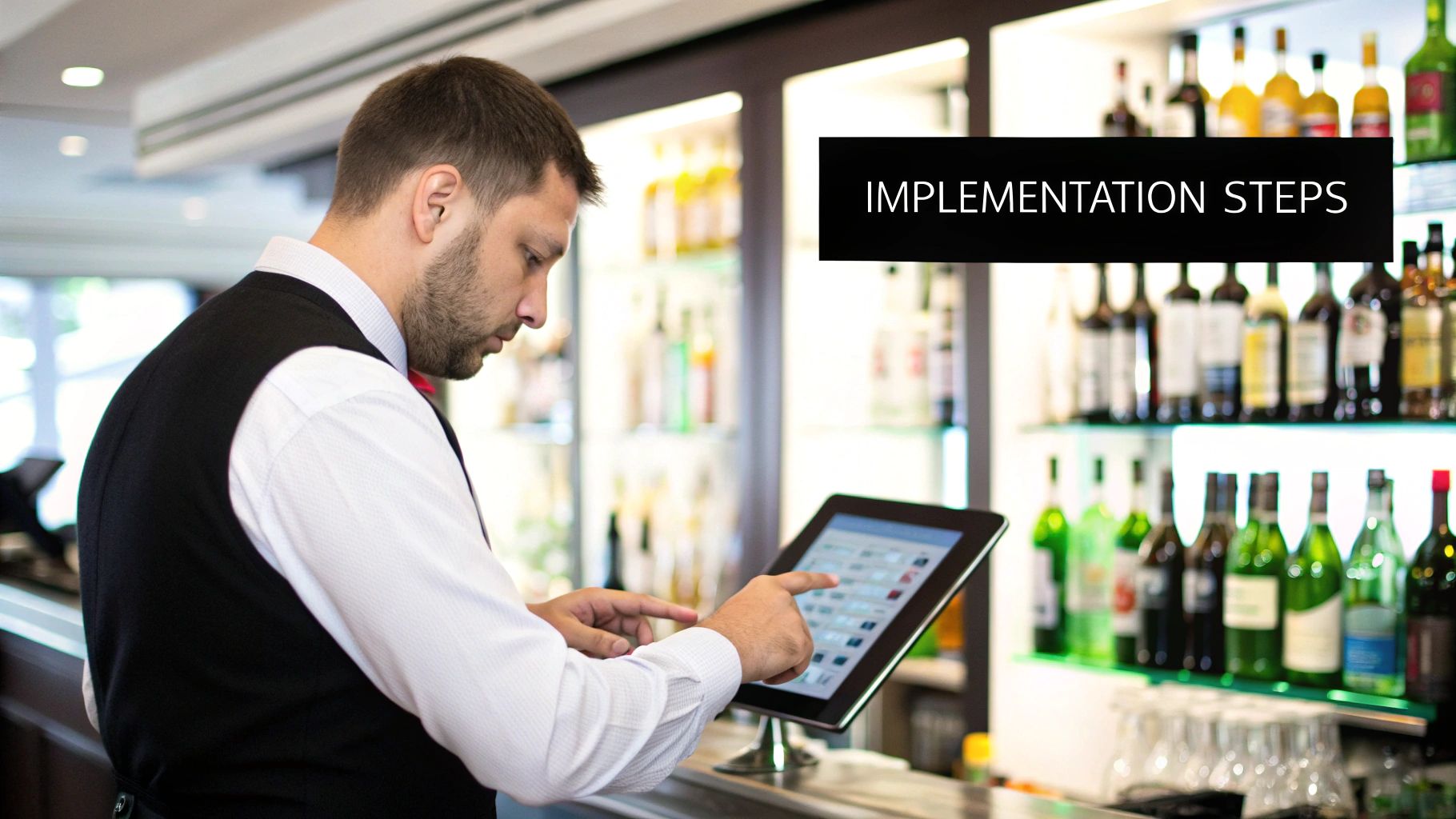
Let's be honest. For any restaurant owner, adopting a new system boils down to one simple question: what’s in it for me? The financial wins from a bar inventory management system aren't just vague promises; they're real, tangible impacts you'll see on your bottom line. These platforms directly plug the silent leaks that drain cash from your business every single day, giving you a competitive edge.
The biggest and fastest payoff? Slashing your shrinkage. Shrinkage is just a nice industry term for all the ways you lose product—over-pouring, spills, comps that were never approved, and even outright theft. Without a system to track every drop, it's impossible to know if that missing bottle of premium vodka walked out the door or was used to make a round of martinis. A smart system gives you that clarity, turning expensive mysteries into solvable problems.
Freeing Up Capital and Saving Time
Beyond just stopping losses, these systems completely change how you handle your cash flow. When you have solid data, your purchasing decisions become surgical. You stop tying up thousands of dollars in slow-moving bottles that do little more than collect dust on a back shelf.
Instead, you can redirect that capital into high-demand products that fly off the shelf, making every dollar you spend on stock work harder for you. And once you have that stock, organizing it properly is key. For a deep dive on setting up your space, check out our guide on commercial kitchen storage solutions to keep your inventory secure and easy to access.
The time savings are just as significant. We’ve all been there—late nights spent with a clipboard, trying to count every last bottle. It's a massive time-sink that pulls managers away from a dozen other critical tasks.
By automating the tedious work of counting and ordering, you free up your best people. They can finally shift their focus from spreadsheets to what truly matters: improving the guest experience, training your team, and actually driving sales on the floor.
This shift toward efficiency is why the market for this technology is blowing up. Bar and brewery operations are going digital, pushing the global market for beverage inventory management software to an estimated USD 1.42 billion in 2024. As more bars get on board, trying to compete with pen and paper becomes a serious disadvantage.
Driving Smarter Menu Decisions
Finally, a great inventory system gives you a direct line from your stockroom data to your menu strategy. When you can analyze pour costs and sales velocity with pinpoint accuracy, you instantly see which drinks are your cash cows and which ones are duds. This data is the secret ingredient for smart menu engineering.
Armed with this knowledge, you can confidently run specials on high-margin cocktails, tweak pricing based on real costs, or kill off underperforming drinks to make room for the next big hit. Every decision becomes a strategic move designed to squeeze more profit out of every sale, turning your bar into a much tougher, more profitable business.
How to Choose the Right System for Your Bar
Picking the right software partner for your bar can feel overwhelming, but it doesn't have to be. The secret is to ignore the flashy bells and whistles and focus on what’s actually going to solve your problems. A system built for a massive nightclub probably isn't the right fit for your cozy wine bar, and that's okay. You're looking for a tool that feels like a part of your team, not another chore.
Think about your staff first. The most sophisticated bar inventory management systems on the market are worthless if your bartenders hate using them. Is the interface clean and simple? Can they figure it out without a massive instruction manual? If it takes an hour of training just to count a few bottles, your team will drop it the second a Friday night rush hits, and you'll be right back where you started.
Evaluate Core Technical Needs
Before you schedule a single demo, take a hard look at what you’re already working with. Compatibility is everything. If a new system can't talk to your existing Point of Sale (POS) system, you're just creating more work for yourself with manual data entry and endless headaches trying to match up the numbers.
Here are the big technical questions you need to answer first:
- POS Integration: Does the software have a solid, proven connection to your POS? This is the absolute foundation. A good integration means your sales data flows directly into your inventory counts without you lifting a finger.
- Hardware Requirements: What gear do you need to buy? Some systems require their own special scanners or scales, while others can run on a standard iPad or even your phone. Those hidden hardware costs can sneak up on you fast.
- Scalability: Think about where you want to be in five years. If you open a second location or double the size of your drink menu, will this software be able to keep up? You want a partner for the long run, not just a temporary fix.
Be wary of any system that tries to lock you into their own hardware or software. The best tools are the ones that play nicely with others.
Key Questions to Ask Every Vendor
Once you have a shortlist, it's time to start asking the tough questions. You're not just buying software; you're bringing on a new business partner. Don't be shy about digging into the details. A vendor who believes in their product will have straightforward answers.
Here’s a checklist of questions you should ask every single provider:
- What is the real total cost? Get a full breakdown. Ask about setup fees, training costs, hardware, and any extra charges for support or so-called "premium" features.
- What does the onboarding process actually involve? How long does it take to get up and running, and what kind of hands-on help will you get during that crucial first month?
- Can I talk to a current customer? There's no better way to get the truth than by talking to another bar owner who is already using the system day in and day out. Ask for a referral.
- What happens when things go wrong? It's 10 PM on a Saturday, and your system glitches. How fast can you get a human on the phone to help you fix it?
Your final choice should feel like a true partnership, not just a transaction. The right company will offer great support and be invested in helping you protect your bottom line.
Rolling Out Your New System for a Smooth Launch
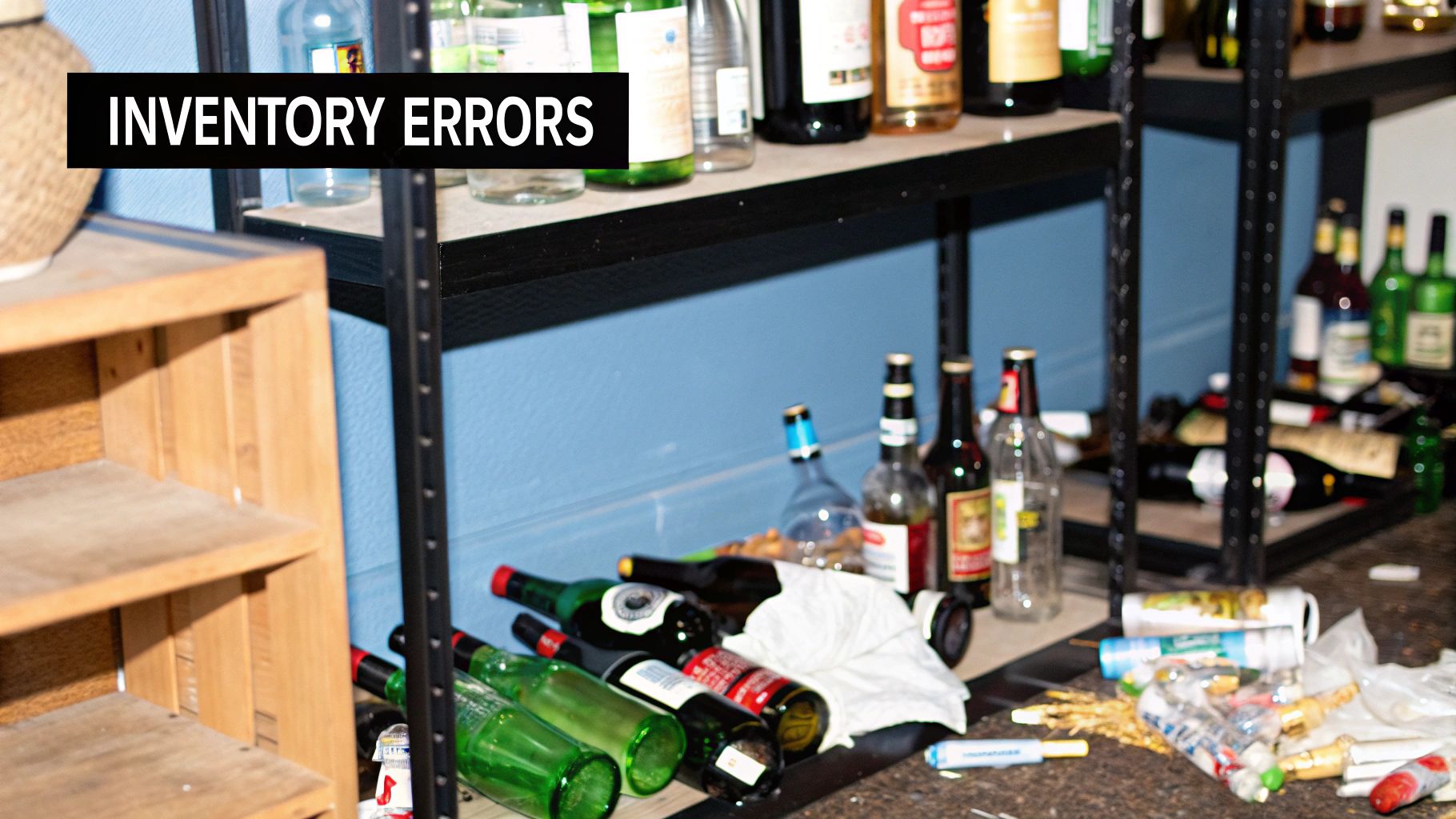
The most powerful technology is only as good as the people using it. A smart rollout plan is what separates a game-changing tool from just another expensive, unused subscription. For bar inventory management systems, a smooth launch starts with clean data and ends with a team that’s fully on board and ready to go.
Your very first step is to create a rock-solid foundation. This means doing a complete, wall-to-wall physical inventory count before you input a single number into the new software. I know, it’s tedious, but starting with inaccurate data is like trying to build a house on a shaky foundation—it’s guaranteed to cause major headaches down the road.
Once your initial counts are in, it’s time to digitize your recipes. Every single cocktail, from a simple gin and tonic to your most complex signature creation, needs to be entered with precise measurements. This is critical because it ensures that every time a drink is rung up on your POS, the system deducts the exact amount of each ingredient, giving you a true, real-time picture of your stock levels.
Earning Your Team's Trust
Let's be honest: the biggest hurdle in launching any new system isn't technical—it's human. If your staff sees this new software as a "gotcha" tool designed to micromanage them or catch them making mistakes, they’ll resist it at every turn.
The key is to frame it as something that makes their jobs easier.
Show them how it eliminates those grueling late-night manual counts. Explain how it prevents the frustration of running out of a popular spirit during a chaotic Saturday night rush. You have to emphasize that the goal is to spot and fix operational issues, not to play detective. When your team understands the system is there to support them, getting their buy-in becomes a whole lot easier.
For a complete guide on getting your operation ready from the ground up, check out our detailed checklist for a restaurant opening to make sure you've covered all your bases.
Integrating the System into Daily Routines
With your data loaded and your team trained, the final phase is to weave the system into your bar’s daily DNA. This is where you stop just collecting data and start putting it into action. It’s not about counting bottles anymore; it’s about using that information to run a smarter, more profitable business.
Start by implementing these practices immediately:
- Set Your Par Levels: Figure out the minimum amount of each product you need to have on hand at all times. The system can then use these pars to automate purchase orders, which stops you from tying up cash in overstocked products.
- Review Variance Reports Weekly: This report will become your best friend. It shows you the difference between what you should have in stock (based on sales) and what you actually have on the shelf. A high variance on Grey Goose, for instance, is a massive red flag for over-pouring, spills, or even theft.
- Track Waste Diligently: Make it a non-negotiable rule that every spilled drink, comped item, or broken bottle gets logged in the system. This explains discrepancies in your variance reports and keeps your inventory data clean and accurate.
By making these routines a core part of your operations, you build a culture of accountability. The system becomes the single source of truth, empowering you and your managers to catch costly issues before they spiral out of control and start eating into your bottom line.
This data-first approach also helps you stay agile. Industry analysis shows that modern inventory systems help bars react quickly to changing customer tastes and supply chain hiccups. Suddenly, your inventory management becomes a powerful tool for marketing and menu development, helping you hit the ground running and stay ahead of the curve.
Your Top Bar Inventory Questions, Answered
Alright, let's talk about what really matters when you're considering a bar inventory management system. As a restaurant owner or chef, you've got practical questions that need straight answers. Forget the sales pitches—you want to know how this will impact your day-to-day, your bottom line, and your team.
We’ve pulled together the most common questions we hear from people in your shoes. This is your no-nonsense guide to help you figure out if one of these systems is the right move for you and discover the latest trends in restaurant equipment.
How Much Do Bar Inventory Management Systems Typically Cost?
There’s no one-size-fits-all answer here. The cost really depends on how much horsepower you need under the hood. For a smaller spot just getting started, a simple app-based tool might run you $50 to $100 a month. But if you're looking for a more robust platform with deep POS integration and serious analytics, you’re probably looking at a range of $150 to over $400 monthly.
Don't just stop at the monthly subscription fee, though. You need to dig a little deeper. Make sure to ask vendors about any hidden costs like one-time setup fees, charges for proprietary hardware (like special scanners), or pricing tiers that jump up as your business grows. Getting a clear picture of the total cost of ownership is the only way to know if you'll actually see a return on your investment.
Can These Systems Integrate With My Existing POS?
This is a big one. The short answer is yes, most modern inventory platforms are built to play nice with popular POS systems like Toast, Square, and Lightspeed. But you absolutely cannot just assume it will work.
A rock-solid integration is the whole point. It’s what lets your sales data flow directly into your stock counts in real time, saving you from hours of mind-numbing data entry. This connection is what gives you that live, accurate snapshot of what’s on your shelves. So, always, always confirm that the system you’re looking at has a proven, reliable connection with your specific POS.
Pro Tip: Before signing anything, ask for a list of their POS partners. Even better, ask for a reference from another bar that’s using the exact same integration you are. A five-minute phone call can save you months of headaches down the road.
How Long Does Implementation Usually Take?
Getting a new system off the ground depends on the size of your operation and how much booze you have to count. For a typical bar, that first big inventory count—getting every bottle, keg, and can into the system—can take anywhere from a few days to a solid week.
Once the initial data is in, you have to account for getting your team trained up, which might take another few days. Realistically, a dedicated manager can get a new system fully rolled out and running smoothly within one to two weeks. The key is having a clear plan; a chaotic rollout will only disrupt service and frustrate everyone.
How Do I Get My Staff to Actually Use the New System?
This is where the rubber meets the road. You can have the best system in the world, but if your team doesn't use it, it’s worthless. The secret is to frame it as a tool that makes their jobs easier, not a "Big Brother" tactic to watch their every move.
Here are a few things that actually work:
- Show Them the "Why": Explain how it helps them avoid running out of a popular vodka on a slammed Saturday night or how it makes ordering a two-minute task instead of a two-hour ordeal.
- Give Them a Say: If you can, bring your lead bartenders or managers into the decision-making process. When they have a sense of ownership, they’re more likely to champion it.
- Train, Don't Just Tell: Make sure everyone feels 100% comfortable using the software. A little confidence goes a long way.
- It’s About the Process, Not the Person: Make it clear that the goal is to spot operational leaks and make the whole bar more efficient—not to point fingers when a bottle goes missing.
At Encore Seattle Restaurant Equipment, we know that a profitable bar starts with the right foundation. We supply the high-quality, reliable restaurant equipment and supplies you need to manage your inventory effectively, from commercial refrigeration to state-of-the-art beverage dispensers. Explore our full selection of bar equipment and build an operation you can be proud of while discovering exclusive deals on the gear you need to succeed.
